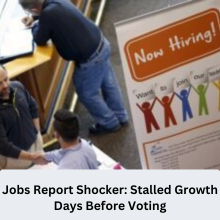
As the election approaches, the U.S. job market faces scrutiny. In October, employers added just 12,000 jobs, raising alarms about economic stability. With the unemployment rate steady at 4.1%, this report holds significant weight for voters concerned about economic performance. Let’s dive into the details of this latest jobs report and its implications for the upcoming election.
A Closer Look at October’s Job Numbers
Stagnation in Job Creation
The 12,000 jobs added in October is a stark drop from previous months. This number is particularly low, marking the smallest gain since late 2020. Factors like strikes and hurricanes played a significant role in this slowdown.
Impact of Strikes and Storms
The Boeing strike alone is estimated to have reduced job numbers by 44,000 in the manufacturing sector. Additionally, storms like hurricanes Helene and Milton have further complicated the employment landscape. While these events are significant, economists warn that they shouldn’t overshadow longer-term trends.
Political Reactions: Democrats vs. Republicans
Economy as a Political Weapon
As expected, the job report quickly became a talking point in the election. Both parties seized the opportunity to leverage the numbers for their narratives.
Democratic Defense
The Biden administration asserts that the sluggish job numbers are temporary. President Biden emphasized that the U.S. economy is fundamentally strong. He noted that the average unemployment rate during his administration is the lowest of any president’s tenure.
Republican Critique
On the flip side, the Trump campaign called the report a “catastrophe.” They argue it reflects poor economic management by Vice President Kamala Harris. This blame game highlights the economy as a central issue in the upcoming election.
Understanding the Unemployment Rate
Steady but Troubling
Despite the disappointing job growth, the unemployment rate held steady at 4.1%. This stability is somewhat reassuring but raises questions about underlying economic health.
Broader Measures of Unemployment
The broader measure of unemployment, which includes discouraged workers and people taking part-time jobs for economic reasons, also remained unchanged at 7.7%. This indicates that while the headline unemployment rate looks stable, the labor market’s overall health may be more precarious.
Wage Growth: A Silver Lining?
Earnings on the Rise
Interestingly, average hourly earnings increased by 0.4% in October, which is slightly better than expectations. This brings the year-over-year wage growth to 4%, a positive sign for workers amid job uncertainties.
The Importance of Real Wages
While wage growth is encouraging, it must be understood in the context of inflation. If prices rise faster than wages, the purchasing power of consumers could diminish, undermining the benefits of higher earnings.
Market Reactions: Investors Respond
Stock Market Stability
Despite the grim job numbers, stock markets responded positively. The S&P 500 and Nasdaq saw gains shortly after the report was released, suggesting that investors may view the jobs report as a temporary setback rather than a long-term issue.
Interest Rate Speculation
This weak jobs report raises expectations for a potential interest rate cut by the Federal Reserve. Financial markets are now pricing in a strong likelihood that the Fed will lower rates in the coming months. This move could stimulate growth but also poses risks if the economy shows further signs of weakness.
Sector Performance: Winners and Losers
Healthcare and Government Jobs
In October, healthcare and government sectors led job creation, adding 52,000 and 40,000 positions, respectively. This is significant because it shows where growth is still happening, even amid broader economic challenges.
Manufacturing Struggles
Manufacturing faced notable declines, losing 46,000 jobs overall. This sector’s troubles reflect broader issues, such as strikes and external disruptions, indicating a worrying trend for one of the economy’s critical pillars.
Also read: Hurry! Montana Millionaire Tickets Selling Like Hotcakes
Analyzing the Labor Market’s Health
Temporary vs. Permanent Changes
Experts warn that while October’s numbers reflect disruptions, they should not be seen as a signal of a collapsing job market. Cory Stahle, an economist, suggests that the impacts of storms and strikes are real but likely temporary.
Long-Term Trends
Job creation had previously averaged around 200,000 jobs a month in 2024. Although this is lower than the previous year, it still indicates a reasonable pace of hiring, which is crucial for economic growth.
What’s Next? Preparing for the Election
The Stakes for Voters
As voters head to the polls, the economy is at the forefront of their minds. This job report casts a shadow on the current administration’s economic narrative. The election results could hinge on public perception of economic management.
The Candidates’ Economic Plans
With the election looming, both candidates will likely continue to emphasize their economic strategies. Voters will need to weigh these proposals against the backdrop of the current economic situation.
Also read: Stream Classic Nintendo Tunes with This New App Today
Conclusion: A Crucial Moment for the Economy
The latest jobs report reveals significant challenges for the U.S. job market just days before a pivotal election. With job growth stalling and political implications heating up, the economy remains a critical issue for voters. How these factors play out in the election could reshape the political landscape and influence economic policy moving forward.
FAQs
Why did job growth stall in October?
Job growth stalled primarily due to strikes and adverse weather conditions, including hurricanes.
What does the unemployment rate indicate?
The unemployment rate of 4.1% indicates a steady job market, but broader measures show potential weaknesses in employment.
How does wage growth affect the economy?
Wage growth can improve consumer spending, but it must outpace inflation to enhance purchasing power.
What are the market implications of the jobs report?
The weak jobs report may lead to interest rate cuts by the Federal Reserve, which can stimulate the economy but also carries risks.
How does this report impact the upcoming election?
The jobs report highlights economic challenges, influencing voter perceptions and strategies for both parties leading up to the election.

